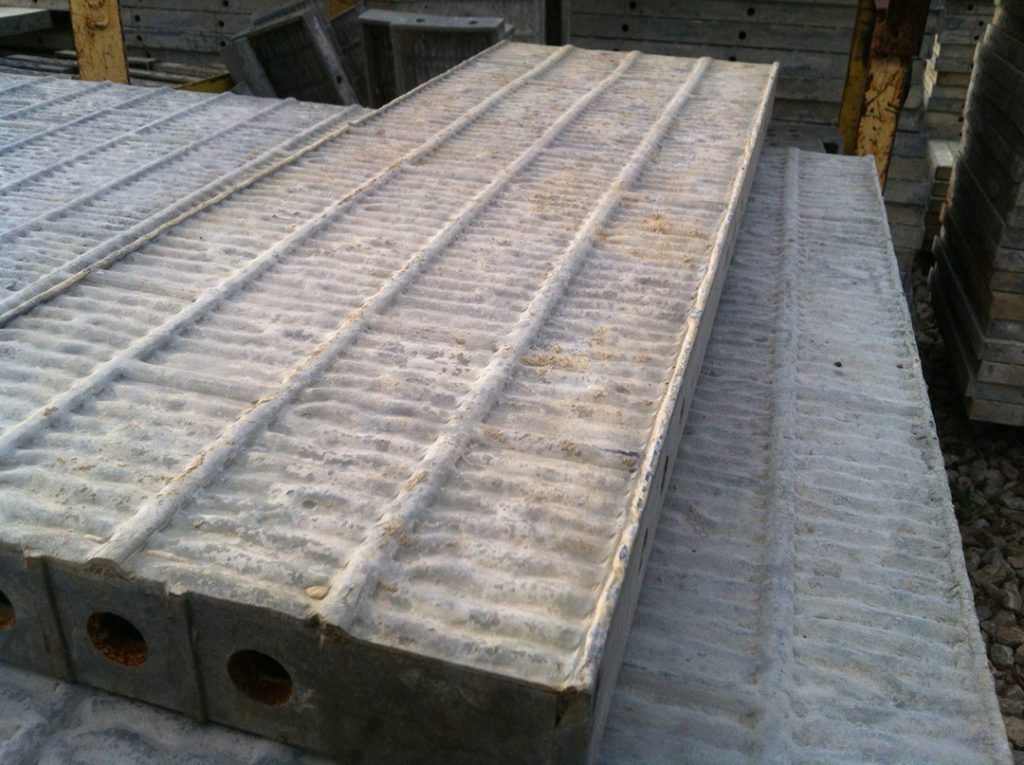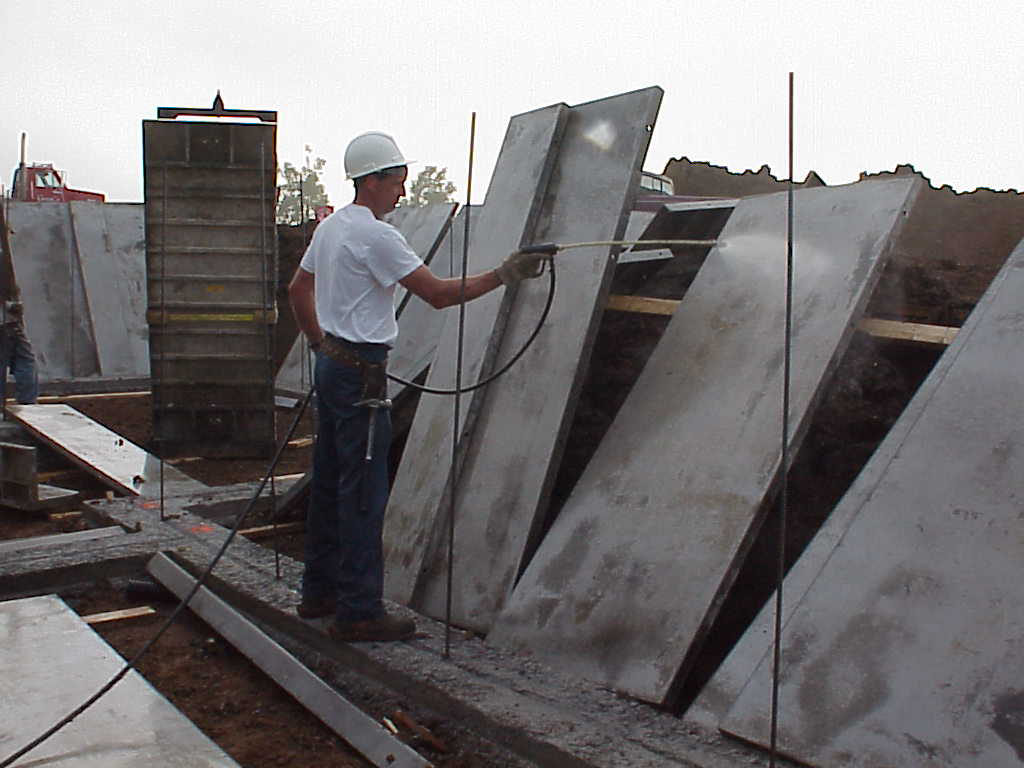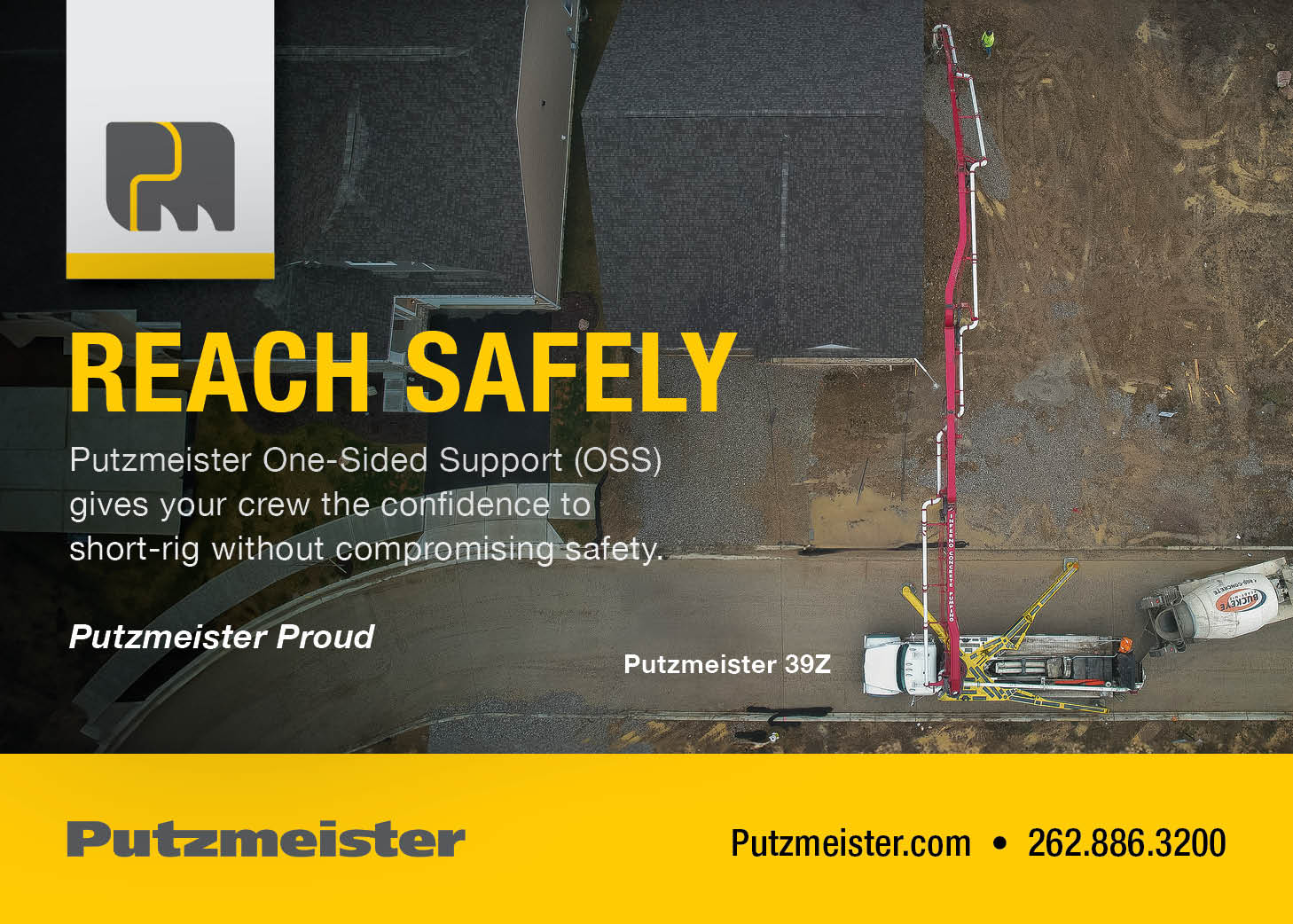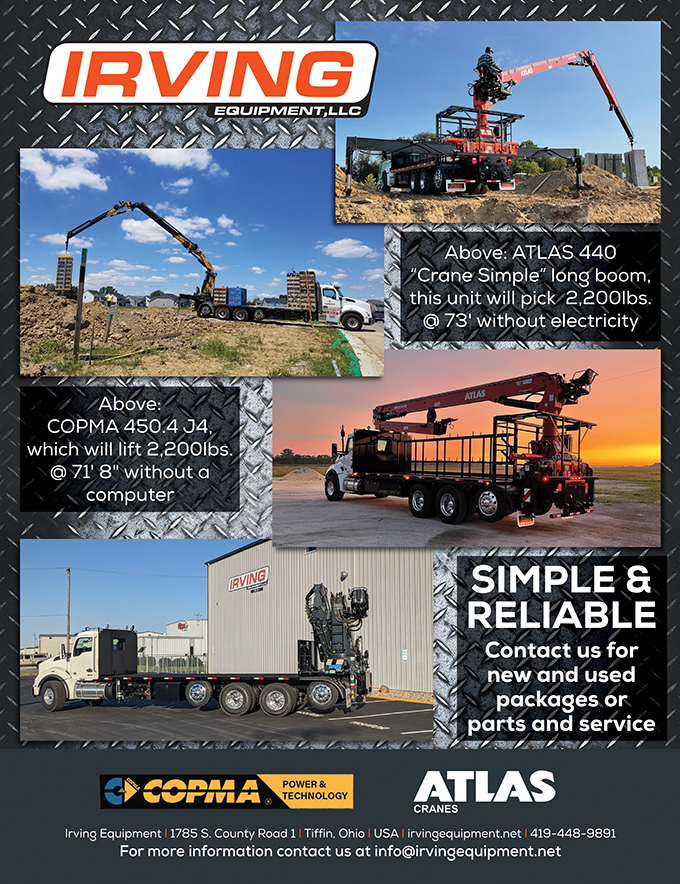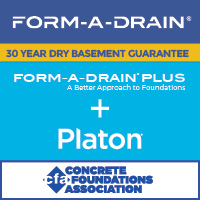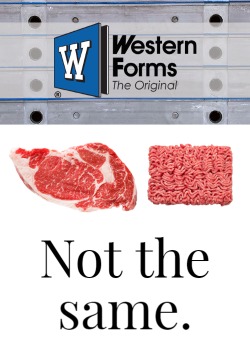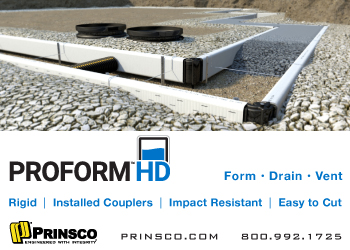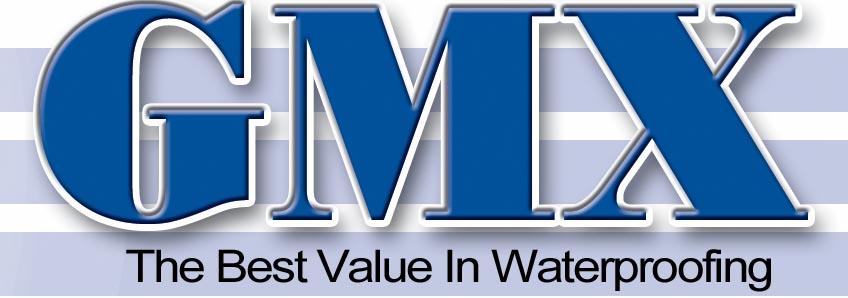Casting Residential Foundation Walls in Cold Weather
By James R Baty II, F.ACI, Executive Director
During a recent CFA event, conversation took place regarding the research significance undertaken by the Association at the start of this new millennium – research that was, in most respects, the first of its kind. What plagued the industry at that time was scrutiny that concrete placed during conditions deemed as “cold weather” was in conflict with the then-current codes. As a current reader of Concrete Facts, it is probable that such research is new to you, considering this magazine has only been a free-subscription resource to the marketplace for about five years. And yet, this research is repeatedly lifted to our attention as having an instrumental role in regional progress for the acceptance of quality control measures for cold weather concrete. Therefore, we are revisiting this topic here, at the onset of the cold-weather season (though many have already been at it for a month), complete with updated references.
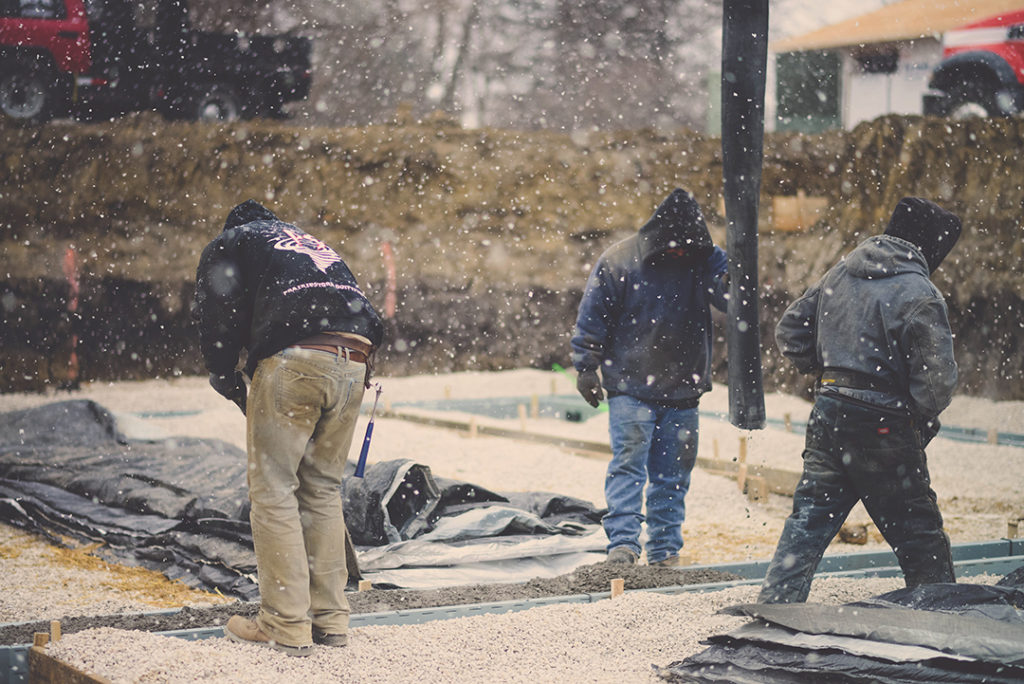
In 2004, a research task force developed by the Concrete Foundation Association (CFA) completed a three-year effort to better understand the performance of residential concrete foundation walls cast during extreme cold-weather conditions. This research began with moderate cold-weather impacts investigated in laboratory conditions and finished with actual extreme cold-weather job site conditions. The purpose of this research was to provide the industry with rationale practices to maintain concrete quality with budget sensitivity.
Before this research, concrete technology and, more importantly, cold-weather guidance and standards (as they related to cold weather) were largely founded on the premise that concrete freezes early on in temperature decline and ceases to gain strength once frozen. At that time, it was felt that nearly every contractor negatively impacted residential concrete by adding water. The purpose of adding water during cold weather was assumed to be solely to make it easier for contractors to work, or perhaps to improve the concrete flow throughout the formwork, weakening the concrete enough to be of structural concern. Some documented cases resulted in surface deficiencies and long-term durability impact to the aesthetics of the concrete surface. Residential concrete foundation walls, however, have always demonstrated higher-than-expected strength. While misuse of water was the primary concerning focus for cold-weather concreting, many other misconceptions and influences contributed to the larger diagnosis that there are definitely times that are “too cold to pour.” This began to come to a head as key industry guides and standards, such as ACI 306, evolved to be far too restrictive. This regulatory tightening happened despite significant empirical evidence and experienced construction practice that supported far less restrictive measures. As a result, prior to the completion of this research (and perhaps even still today), building officials and inspectors routinely shut down foundation projects, or practically shut them down by requiring heroic measures to cure in-place concrete. The judgments made by such officials are based on a narrow interpretation of theory versus practice and a lack of available information as to what is really important.
The research premise put forth by the CFA recognized the great number of variables that affect the performance of concrete in cold temperatures. These variables include mass-to-surface-area ratio, protection from evaporation, limited exposure to wind effects (below grade), forming system and admixtures. This more complex picture gives evidence that regulations governing concrete pours in cold weather should be performance-based with the ability to predict, respond and monitor the achievable concrete quality as more than a function of the weather forecast.
Even today, in some regions, residential foundation contractors find either local codes or mindsets so restrictive during winter months that the residential market’s economy is significantly jeopardized. Restrictive requirements included tenting and heating, full blanketing, curing protection until achieving full design strength, and prohibiting or altering placements in temperatures as high as 50 F. While there are preparation and equipment limitations in some markets for the production and delivery of higher-target concrete temperatures, cold-weather concrete is a broad topic that needs to be more fully understood and embraced.
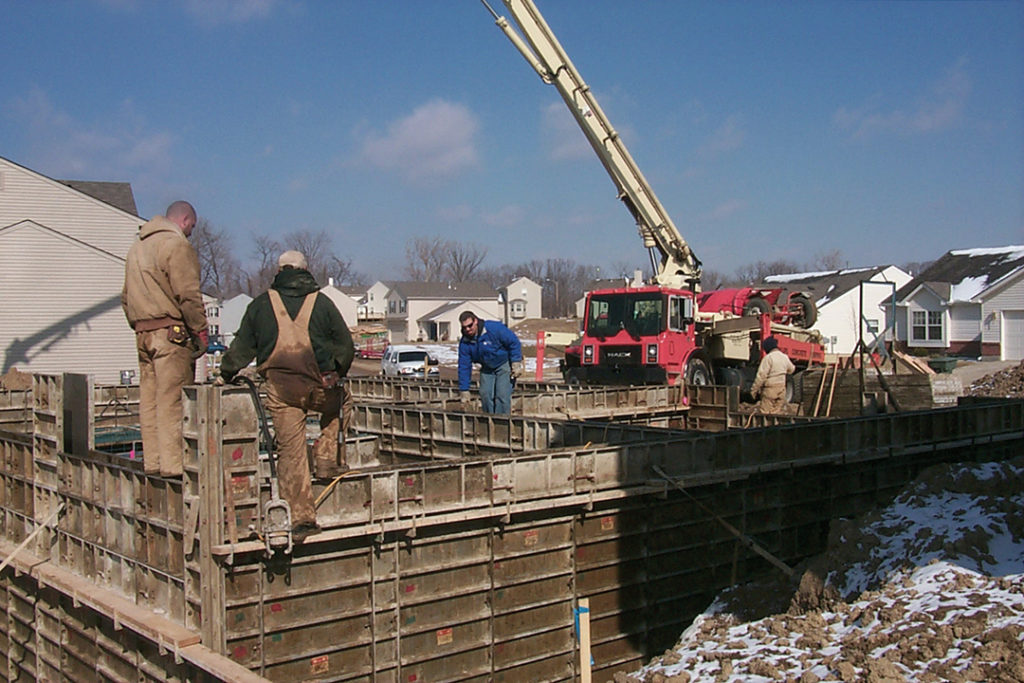
An encouraging fact to know as a contractor in the industry is that reliable research has changed many mindsets and code requirements. Not only do contractors continue to report much greater ease of cold-weather foundation efforts, but they also report greater concrete durability and many self-imposed practices that are improving both the concrete work and the concrete quality. While the information the rest of this article presents is largely from the completion of the 2004 research, it remains important for each contractor active in the residential industry to be mindful of entering a new season of cold weather and knowing where to go for support and third-party assurance.
The Research Project
The interests of residential contractors and the economy of residential concrete during the winter months motivated the CFA to initiate a substantial research project designed to:
- Identify the actual performance of concrete at low temperatures.
- Provide information that would help differentiate between excessive measures and concerns outlined in building codes.
- Recommend intelligent or common-sense practices to be followed.
The goal of the research program was to provide “real world” data about mixes that contractors regularly use, the performance of those mixes at a variety of target temperatures, and what economical modifications should be made to achieve improved performances and results. Due to the realization that variability in concrete exists throughout the U.S. market, the research results were intended to allow contractors to adapt mix designs for regional differences. The complex research came in multiple phases that systematically addressed misconceptions and then showed the viability of the contractor and ready-mix producer working more closely together while contributing sound evidence to prove performance.
The Research Stages
Phase 1 – Following regional surveys, the research committee selected 36 representative mix designs to be tested under laboratory conditions. Concrete mixes were tested in a laboratory provided by Master Builders (now BASF) at 30 F and 50 F ambient conditions. These temperatures were implemented to more closely represent target temperatures being reported by the market as weather predictions when inspectors would begin targeting job sites for delays.
Phase 2 – Full-scale field research studies were then initiated under sub-freezing conditions using a selected sub-set of the original 36 mixes that represented the broadest economic array. All mixes were designed with 6 percent air-entrainment and a slump of 6-inches. All mix components were stored at 60 degrees Fahrenheit prior to batching. By the end of the project, more than 20 cubic yards of concrete had been batched and tested in more than 850 cylinders and 12 wall samples.
Phase 3 – Finally, further results for field data were gathered from 180 core samples taken at varying intervals from the wall samples. These cores were subjected to both compression and petrographic tests to determine the impact of the extreme weather conditions on strength and durability.
Throughout the program, the research implemented maturity testing, which is the science of predicting concrete’s strength gain over time given the mixture’s components and the placement’s temperature profile. The research matrix (fig. 1) produced from Phase 1 shows 44 maturity curves derived from the 36 mix designs subjected to 30 F and 50 F temperatures. Throughout the research, probes monitored representative cylinders and all wall samples, tracking both internal concrete and ambient temperatures.
Phase I – Testing in the Laboratory
To develop a thorough understanding of the strength gain for the various mixtures, 6-by-12-inch cylinders were cast and placed into a refrigerated (50 F) or frozen (30 F) chamber. Cylinders cured at these temperatures were then tested for compressive strength at 1, 2, 3, 7, 14 and 28 days and compared to their maturity curves. This phase consisted of 660 cylinders (fig. 2). The cement for the mixes consisted of either Type I or Type III, with content as low as 5-sack (470 pounds) and as high as 6.5-sack (611 pounds). Because admixtures can contribute to strength gain, especially at lower temperatures, the addition of 1 percent and 2 percent calcium chloride, mid-range water reducers (MRWR), and a non-chloride accelerator (NCR) were also tested.
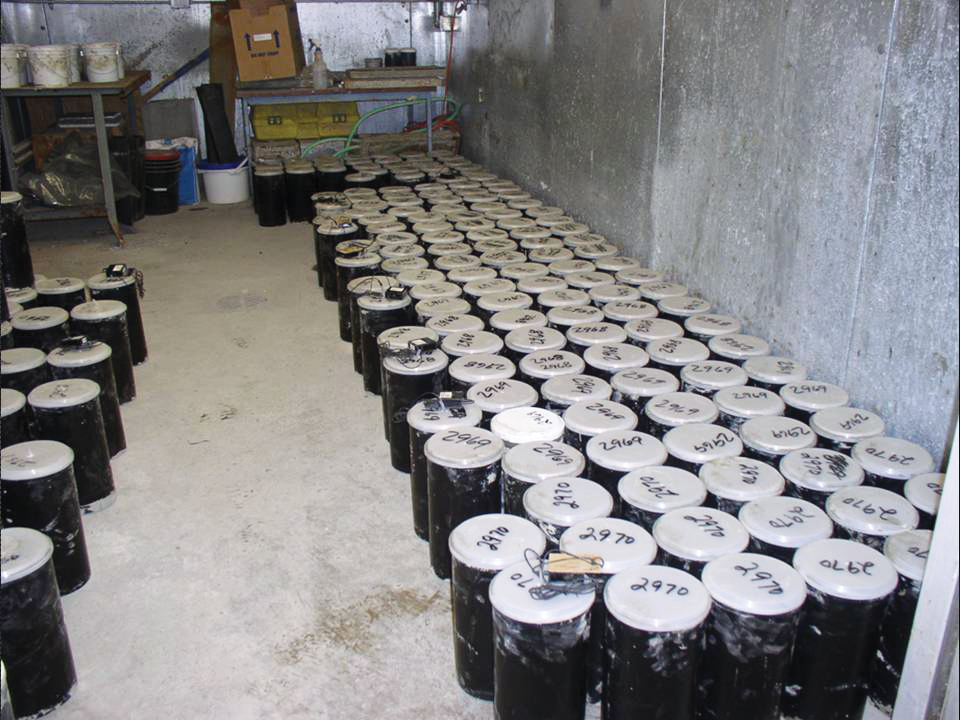
Phase II – Testing in the Field
Phase II brought about field research following closely upon the completion of the Phase I Laboratory research. In this phase, actual eight-inch walls were formed eight feet high in modified job site conditions. The walls were only six-foot-wide segments, and instead of being placed in an excavation, they were formed in a simulated excavation environment in Medina, Ohio, in the yard of Osborne-Medina Ready Mix. The concrete mixes selected from Phase I (fig. 3) represented the most favorable combination of performance and economy.
Figure 3 – Field Research: Phase I Mixes Selected for Phase II
| Mix | Cement Qty. | Cement Type | Admixture |
| 3 | 5-sack | I | 2% Calcium* |
| 8 | 5.5-sack | I | 2% Calcium* |
| 13 | 6-sack | I | 2% Calcium* |
| 24 | 5-sack | III | 1% Calcium* |
| 29 | 5.5-sack | III | 1% Calcium* |
| 34 | 6-sack | III | 1% Calcium* |
*ACI 332-14 permits the use of up to two percent calcium chloride by cementitious weight (one percent by water-soluble chloride ion), provided steel reinforcement is not required for structural performance. Steel reinforcement intended for temperature and shrinkage crack control, such as horizontal or re-entrant corner steel, is not considered structural by definition.
Each mix was tested in an uncovered wall segment as well as in a segment covered with a six-foot blanket capping the top (fig. 4). Wall forms were removed from all segments after 24 hours, as were the blankets of the covered walls. Both internal and ambient temperatures were monitored for the walls, as was a full set of test cylinders from each mix. Once the wall forms were removed, cores were taken and tested along with cylinders at 1, 2, 3, 7, 14 and 28 days. Conditions at placement were 26 F, with snowfall. The temperature remained below freezing for 21 days, with an average temperature in the low teens and a low temperature recording of -19 F. The opportunity to record the strength gain of the full-scale walls at such favorable research temperatures was an added bonus.
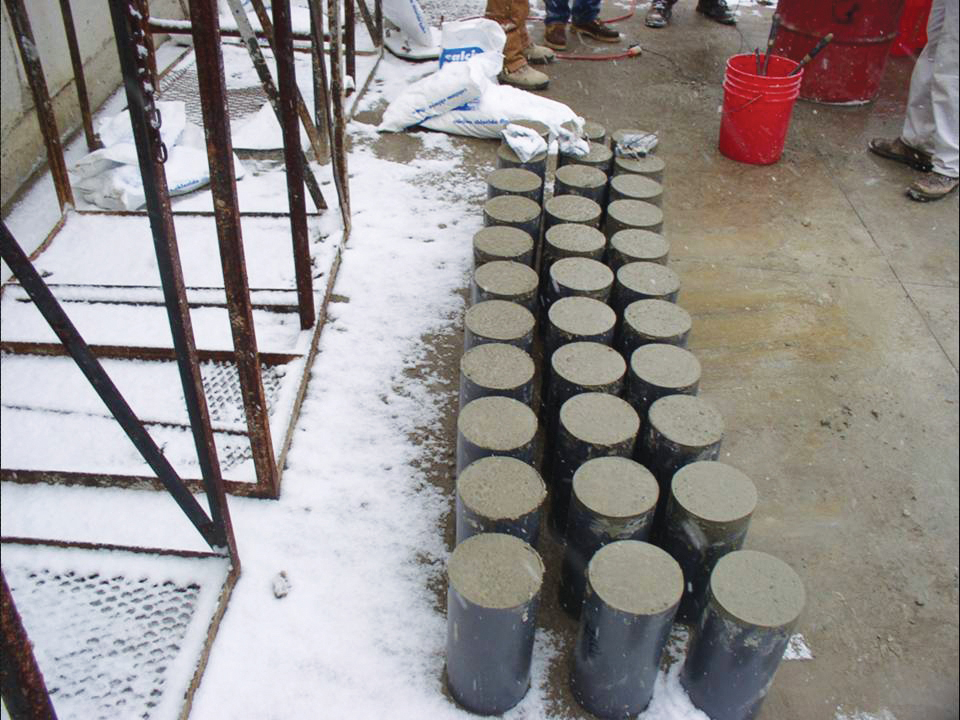
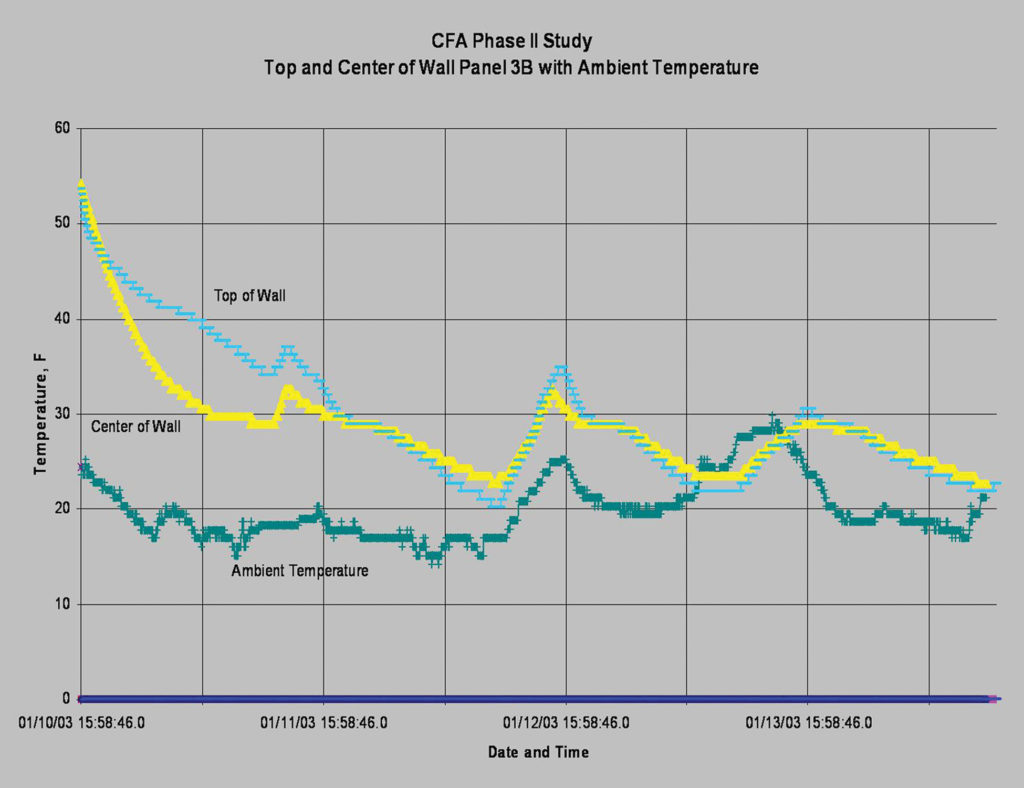
Phase III – Petrographic Testing
The final phase of the research project was petrographic examination of the cores taken from the field segments. Each mix type and location (covered versus uncovered for the first 24 hours) was subjected to petrography to determine the impact any freezing condition may have on the concrete. While there was definitive evidence that the range of mixes were affected by an initial set freezing, the typical freeze/thaw cycle that the samples were subjected to failed to produce continued deterioration. The behavior of all samples was such that the lab technician could not determine whether the samples were indicative of winter behavior or summer behavior.
Results from the Testing
The data resulting from the three-phase project reinforces the more generally applied ability to predict strength gains in concrete exposed to cold weather conditions. Additionally, the data supports the idea that concrete’s foundation-wall environment is naturally protected from the detrimental impact of freezing. Most importantly, the research evidenced that maturity resumes for concrete when internal temperatures rise above freezing.
There are many more results and recommendations established by this research effort. The research continues to inform practical, effective and intelligent decisions for professional foundation contractors throughout North America. It has made a significant impact in the industry, now referenced by ACI 332 (and, by reference, the IRC) and by the ACI 306 Guide to Cold Weather Concrete. Since its publication, ACI 306 is now in its third revision and no longer presents cold weather as requiring protection below 40 F. The guide presents a conversation about protection and a decision-making process that encompasses many of the research results validated through this project.
CFA now offers two important resources relative to this research. The first is a 72-page research report with complete details on the mix designs, each phase test parameters and the recorded performance from each component. It is available from the CFA through online resources or by contacting our headquarters. This research report has also become part of the technical resources that form the basis of the ACI/CFA Residential Foundation Technician Certification. A condensed technical reference sheet is also available as a great communication tool for the principal findings is publicly available from the CFA website under Resources and can influence the conversation as well as confirm some of the more frequent practices influenced by the research.

Determine What Is Next
Should you be interested in a more interactive discussion of these research findings, CFA members have access to a free online webinar held periodically throughout the year. Additionally, you can listen to a podcast that will soon be added to “Behind the Mic” – an audio-format discussion of great topics. Contact us for the details on the schedule, or visit our website for more information on registering for one of these.
What Causes Concrete Build-up on Forms
Part 3 of a 4-Part Series By Destry Kenning, Forming Market Segment Manager, Nox-Crete Products Group
Just about all concrete-forming contractors will tell you that one of the challenges they face on job sites is keeping their forms clean, or, more specifically, preventing concrete buildup on the working faces of their forms.
Theoretically, if you cover the forms with a good coat of a quality form release agent prior to placing concrete against them, you should never have to worry about concrete buildup, right?
Any experienced wall-forming contractor will tell you that projects never seem to work out that way. While contractors hate having the concrete buildup on their forms, they have, in many cases, simply learned to live with it.
Thankfully, the process of inevitable buildup does not need to be this way.
In this article, the focus will be on why concrete buildup occurs. In a subsequent and final article in this series, the focus will be on how to eliminate the buildup when it does occur.
The primary causes of concrete buildup include:
- Unseasoned or improperly seasoned aluminum forms
- Poor-quality form release agent
- Insufficient amount of form release agent or no form release agent at all
- Applying form release agent after forms are set, rather than before they are set
- Form surface abrasion during concrete placement
- Use of a calcium chloride accelerator in concrete cast against aluminum forms
- Early form removal
Editor’s note: Further details on each of these will be addressed in the final part of this article series in March.
SEASONING – As mentioned in the first article in this series, Dealing with the Reactivity of Aluminum Forms and Concrete, aluminum form surfaces must be properly seasoned when new, or re-seasoned following aggressively cleaning them or removing buildup.
Aluminum is very reactive with the cementitious material content. If the aluminum is not properly seasoned, severe buildup will occur from placing concrete against it, irrespective of the presence of a good quality form release agent.
This type of buildup is by far the most common on aluminum forms. This buildup also happens to be the most difficult to remove because it is usually chemically bonded to the form surfaces rather than just being physically bonded. Because the chemically bonded concrete buildup is several times more difficult to break loose than the physically bonded buildup, it is the most important type to prevent.
Once the forms have been properly seasoned, preserving the seasoning layer should be the highest priority in the battle against concrete buildup.
As emphasized in the first article, the seasoning layer is somewhat delicate, especially on newly seasoned forms. The list of the most common things that can alter the seasoning layer’s integrity include aggressive abrasion during concrete placement and high-dose rates of calcium chloride used as an accelerator in the concrete. These will be addressed in greater detail later in this article.
FORM RELEASE AGENT QUALITY – Wall-forming contractors have to endure more than their fair share of misleading presentations from form release agent manufacturers and distributors alike. Everyone seems to promise better performance or lower pricing, or both; yet it seems like no matter which product is chosen, the buildup prevails. That said, most wall form manufacturers agree that reactive release agents do the best job of keeping concrete buildup off their forms.
The ideal reactive release agent for your specific application is one that keeps buildup at bay and works with both your method of application (assuming it is satisfactory) and the concrete mix designs that you use. If you have dusty or greasy buildup on your forms, then the product you are using is too reactive, or you are applying the product too heavily. On the other hand, if the release agent you are using is leaving you with hard concrete buildup on your forms, then it is not reactive enough, or you are not applying it heavily enough. There is still the chance, however, that something else in your process is causing the problem.
LACK OF FORM RELEASE AGENT – If you asked one hundred wall-forming contractors the question, “Do you need to use a form release agent on your wall forms prior to each pour?” almost all would respond, “Yes,” without hesitation. However, in the rush leading up to each concrete pour, the form release agent does not always get applied on all forms or on all areas of each form. If this happens on overlaid plywood forms, especially on older ones, either overlay damage or concrete buildup will likely occur. If this happens on aluminum forms, new concrete buildup is all but guaranteed.
If there is hardened concrete buildup already on the forms, then the release agent application needs to be heavy enough to saturate the buildup. This way, the product near the surface can react with the new concrete poured against it. If the release agent does not react with the freshly poured concrete, sticking might occur, which would lead to a greater accumulation of buildup on the form surfaces.
APPLICATION OF FORM RELEASE AGENT BEFORE OR AFTER SETTING FORMS – Anyone who has applied a form release agent on wall forms knows that it is not generally a very pleasant experience. In many cases, the form release agent has a nasty smell and the wall crew responsible for erecting the forms wants to avoid getting any of it on them. The aversion to contact with the form release is not only due to the smell, but also due to skin rashes and other health risks associated with some products. And who could blame them for thinking that way?
Most wall-forming crews will tell you that the best way to reduce exposure to the form release agent is to spray-apply the product after the wall forms have been erected. All things considered, is this the best application method to use? More importantly, if the form release agent smells that bad and is also that unhealthy to be around, is that particular product the best form release agent to use? Seriously, if the form release agent you are using limits your application options, then it may be time to reconsider your form release agent options.
There is no denying that the best results are consistently obtained when the form release agent is applied before the forms are set. This method enables the applicator to apply the release agent more consistently and lightly across the entire form surface, which greatly reduces form-release-agent consumption, yields better looking walls, and, most importantly, minimizes the potential for concrete buildup.
Modern form release agents contain lower VOC’s, which means more of what you apply will remain on the forms. Additionally, these lower VOC formulations have higher viscosities, which means they do not flow down the forms as much when spraying from the top after the forms are set. This is especially true during colder weather conditions. All too often, the bottom of the forms do not get fully coated when the form release agent is applied after the forms are set, and if the form release agent is missing when the concrete is placed, form-panel damage and/or buildup become the reality.
FORM SURFACE ABRASION – Form surface abrasion can occur during concrete placement or during consolidation, if internal vibrators are used. This abrasion sometimes removes the applied form release agent, damages the overlays on plywood forms, or removes the seasoning on aluminum forms. The end result is form-sticking and concrete buildup on the form surfaces. When tailgating the concrete into forms, one should use a deflection board, chute funnel or tremie hopper to direct the concrete away from the form surfaces and down the center of the wall-form cavities.
When using a pump to place the concrete, it is important to make sure the trunk on the boom is kept exactly vertical and the concrete flow is directed away from form faces. When brick ledge block-outs are used, or when the wall-form cavity is narrower than the pump trunk or chute funnel, a reducer should be used to prevent the concrete from abrading the form surfaces during placement. Alternatively, the concrete flow should be directed at the brick ledge block-outs and away from the form surfaces on the opposite side of the wall.
Concrete consolidation can be accomplished in several ways. Internal concrete vibrators present the biggest challenge because they can excite the aggregate found between the vibrator heads and the form surfaces. This interaction leads to release agent removal and form surface damage, as mentioned above. Choosing the right vibrator and using it correctly will help prevent these issues from occurring.
Ideally, the vibrator head size should be no greater than 25 percent of the wall thickness. When using the vibrator, the head should be inserted as close to the center of the wall as possible. The vibrator should be allowed to descend into the concrete under its own weight without any added force from the operator. As soon as the vibrator reaches the desired depth, it should be removed at the steady rate necessary to achieve required consolidation. This rate of removal will vary depending on the vibrator and concrete mix. Under no circumstances should the vibrator head be allowed to remain still while submerged in the concrete.
Proper storage of the vibrator is also critical. Never store the vibrator shaft in a coiled state. This can lead to curvature memory and loss of directional control of the vibrator head when submerged deeply into the wall.
CALCIUM CHLORIDE – The addition of calcium chloride accelerators should not be used, no matter the percentage, for the first six pours against newly seasoned aluminum forms. Even with fully seasoned aluminum forms, calcium chloride, particularly at percentages greater than 1.5 percent by weight of cementitious materials, can have a deleterious effect on the protective aluminum-oxide layer formed during the seasoning process. This effect can lead to form-sticking and aggressive buildup.
On the other hand, non-chloride containing accelerators can actually be beneficial for the break-in process of newly seasoned aluminum forms. They can be used at any recommended dose rate, regardless of when the seasoning was completed, because they are not reactive with the aluminum.
EARLY FORM REMOVAL – It is important to know the concrete’s approximate compressive strength at that specific time prior to stripping forms to minimize the potential for a thin film of concrete pulling off the wall and sticking to the form surfaces. Ideally, the concrete should have a minimum compressive strength of 500 psi before the forms are stripped, which is consistent with the American Concrete Institute (ACI) recommendations.
During colder weather conditions, this may mean stripping the forms 24 or more hours after the concrete is placed, which is clearly a longer time period than what is required during warmer conditions.
Temperature, cement content, cement type, chemical admixtures (such as retarders and accelerators), mineral admixtures, and elapsed time from when the concrete was batched will all be influential on the strength gain of the concrete.
Premature stripping during colder weather conditions frequently leads to concrete buildup on the form faces, which is, in many cases, incorrectly associated with poor release-agent performance or inadequate seasoning of aluminum forms.
To prevent this problem from occurring, work with your concrete supplier to develop some strength data for your concrete mix at various temperatures and at various times after the concrete was batched.
Letter From the Director

Thoughts From My Desk…
“You are simply not going to believe it.” This is the phrase I have been using regularly as I talk with many of you reading this magazine, whether you are a CFA member, or one of the many companies across this great country to whom I have the privilege of casting our voice. Where I use this phrase is in the promotion of the one thing CFA is known for more than anything else: our networking.
Listen, I am involved on a daily basis – yes, daily – in resolving conflict in our industry. Often I am fielding a question by a member challenged by an inspector, gathering information to share in defense of a company’s decision to meet an OSHA regulation, or responding to a claim that a company has installed concrete improperly. All of these chances I get to be an advocate for the concrete industry, however, pale in comparison to the impact I see and hear when I am in the same room as company representatives just like you. Yes, you, the one reading this letter… Picture my finger pointing at you.
From “I’m simply too busy” to “We don’t have enough coverage right now,” to “We’re not quite ready to join” – there must be a thousand reasons why more than 5,000 companies receive this magazine but do not do anything more with it. That is not stated to single you out, for you are not alone. In fact, you are in the majority. The majority of companies in this industry, or in any industry, for that matter, will never take the inspired step or the calculated risk to invest in themselves and open up their collective minds to see a much broader picture of potential. And then, there are the 300 or so that do. What does it look like on the inside? That is where my phrase comes in: “You are simply not going to believe it.”
I sat in a meeting two weeks ago in Philadelphia, the same meeting that our president, Phil Marone, was at. In this meeting, only two people knew each other (outside of me as the host, and our education consultant and mentor, Rocky Geans). These happen to be the two companies local to the event. The remainder of the room had never met. When it was all said and done, they could not wait to get back together, as they had begun the formation process to become a Management Exchange Networking group. That doesn’t make things easier; it rewards the harder. The more you expose yourself, opening yourself up to others’ ideas, the more rewarding your future will be. I heard one company describe the challenges they faced in creating their schedules, another in keeping control of workers’ compensation insurance, and another trying to figure out who would call in sick and who would respond to the rescheduling of their work. These were all shared within the group, and everyone had a strategy to share or a corroborating experience; and, as a group, they came to even larger decisions.
You are simply not going to get any better by being the same company tomorrow as you are today. You are not going to open your doors to the competition that is around you, letting it come in and look at your business or listen to your struggles. You are not going to win any battles with customers, inspectors or compliance officers by presenting the same responses you gave last time. The only way to move forward in this industry, or in any industry for that matter, is to stop and consider yourself a leader. Good leaders do not merely follow, and they do not demand. What a good and successful leader will do is make the informed decision to invest in their company by becoming affiliated with like-minded leaders. Then those companies can serve each other by getting in the room, listening and sharing. What do I want for your 2018 Christmas? I absolutely want peace and joy for you, but I also want success – success you are simply not going to believe until you experience it. Become a member!
Letter from the President
Hello CFA Contractor and Associate Members!
With the close of 2018 almost here, I view this as the perfect time to offer some thoughts regarding our businesses and our association.
It seems that each year brings new challenges and that running our businesses takes more of our time and energy. Even in a good economy, we are constantly tested and confronted with decisions to keep us in the black. Increasing regulations, lawsuits, labor shortages, workers’ compensation, material prices and insurances make it complicated to remain profitable. The advancement of technology has made it important to change the ways we do business even more quickly. The five-year plan of the past seems to run its course much more quickly.
All that stated, it is important to look at how we do business more frequently and find ways to improve our processes and procedures to stay on top of a rapidly changing environment.
Our organization is one of the best resources for staying relevant and on top of your game. We have resources, education, and like-member companies to associate with and help keep your businesses fresh! Being a member is one thing, but being an involved member is where the rubber meets the road. As is often said, you can only get out of something what you put into it.
In November, our CFA brought the Rocky Geans Construction School to Philadelphia, along with the opportunity for certification testing. Companies that realized the importance of taking advantage of the membership met for two days of education. Companies from Pittsburgh, Central Pennsylvania, Baltimore, Atlanta, New York, New Jersey and the Philadelphia metro area attended. The event not only educated the attendees, but also opened the door for dialog amongst similar companies. Additionally, the meeting provided some of the companies with an opportunity to get involved with Management Exchange Groups. Initiated several years ago, these are groups of non-competing companies that meet on their own a couple times each year to share information with each other that can further improve each others’ businesses.
The CFA business schools, certification processes, and education opportunities will be available in regional areas in the future. Engaging in these opportunities is a great way to take advantage of our organization. I am personally challenging you to set aside the traditional response that you do not have time, and to find a way to make a difference in your future!
Best wishes for the close of the year, for your families, and for happy holidays!
CONCRETE FOUNDATIONS ASSOCIATION ANNOUNCES NEW AFFINITY MEMBER BENEFIT PROGRAM
FOR IMMEDIATE RELEASE For further information contact: Lindsey Bloomquist Manager of Communications and Networking Concrete Foundations Association Telephone: (319) 895-6940 E-mail: lbloomquist@cfaconcretepros.org
CONCRETE FOUNDATIONS ASSOCIATION ANNOUNCES NEW AFFINITY MEMBER BENEFIT PROGRAM
Mount Vernon, IA November 30, 2018 – The Concrete Foundations Association (CFA) – the recognized voice and authority for the cast-in-place concrete industry, has entered into a relationship with Business AdvantEdge, Inc., to begin saving member organizations thousands of dollars annually simply by maintaining an active CFA membership and registering for specific services.
![]()
Mary Hazzard of Business AdvantEdge states, “We do the work of negotiating with national organizations to deliver savings to individual company users through their affiliation with key organizations like the Concrete Foundations Association. In so doing, an average company using a handful of the services provided through this relationship can easily generate more than $4,000 of annual savings over independently negotiated contracts with these providers.”
Business AdvantEdge is designed to bring BIG business discounts to SMALL businesses. A member benefit driven organization, they offer small business owners and trade associations discounted business inventory and services. “We hold contracts with major supply companies that allow us to pass along savings and other value added in the form of member benefits,” states Hazzard.
“During each Board meeting, our directors discuss ways of entering into agreements with large national firms to leverage our combined buying power,” states James Baty, CFA Executive Director. “Business AdvantEdge approached us with a universal solution and a diverse directory of services we felt was an automatic step in the right direction. Not that the value of membership needed further justification but this is one of those connections that pays you for becoming a member.”
The suite of service providers offered to CFA members beginning this December includes ways to save money on:
- Fleet Fuel and Propane
- Waste and Recycling Management
- Office supplies and Technology
- MRO – Maintenance, Repair and Operations
- HR – Payroll Processing and Employee/Drug Screening
- Shipping
- Workwear and Facility Services
- Truck and Vehicle Rentals
- Telecom – Land and Mobile phone services
Examples of these advantages include Office Depot where up to $70 is saved on the first purchase by 12/10/2018 and up to 65% after that. Also, Fleet Fuel Programs by Exxon Mobil, Phillips 66, Conoco, 76, Stripes and Circle K have per gallon savings between 10 and 15 cents for the first half of 2019 and 5 to 6 cents thereafter.
To find out how you can begin benefitting from these programs or to see the complete line-up of affinity services, contact CFA Executive Director, James Baty for more information on CFA membership and this Business AdvantEdge relationship.
Keep tuned to CFA communications as we launch these terrific new member benefits. You save all year long, however for December, we have several limited time promotions that are available if you act fast! Details and enrollment instructions are found at our new CFA MarketPlace.
ABOUT CONCRETE FOUNDATIONS ASSOCIATION
The Concrete Foundations Association (CFA) is the recognized voice and authority for the residential concrete industry. Originally formed as the Poured Concrete Wall Contractors of America, Inc. (PCWCA), the CFA was formed in 1974 to serve the interests of poured wall contractors. The CFA has members throughout the U.S. and Canada as well as overseas representing all aspects of the cast-in-place industry including construction, design and manufacturing. Member firms are diverse in size and volume as well as business models with many operating across residential, agricultural and commercial markets. For more information, visit www.cfaconcretepros.org or contact CFA at 319-895-6940.
###
Concrete Foundations Association Announces New Member Benefit – Savings4Members
CONCRETE FOUNDATIONS ASSOCIATION ANNOUNCES NEW MEMBER BENEFIT SAVINGS4MEMBERS

Mount Vernon, IA November 30, 2018 – The Concrete Foundations Association (CFA) – the recognized voice and authority for the cast-in-place concrete industry, has entered into a relationship with Business AdvantEdge, Inc., to begin saving member organizations thousands of dollars annually simply by maintaining an active CFA membership and registering for specific services.
Mary Hazzard of Business AdvantEdge states, “We do the work of negotiating with national organizations to deliver savings to individual company users through their affiliation with key organizations like the Concrete Foundation Association. In so doing, an average company using a handful of the services provided through this relationship can easily generate more than $4,000 of annual savings over independently negotiated contracts with these providers.”
Business AdvantEdge is designed to bring BIG business discounts to SMALL businesses. A member benefit driven organization, they offer small business owners and trade associations discounted business inventory and services. “We hold contracts with major supply companies that allow us to pass along savings and other value added in the form of member benefits,” states Hazzard.
“During each Board meeting, our directors discuss ways of entering into agreements with large national firms to leverage our combined buying power,” states James Baty, CFA Executive Director. “Business AdvantEdge approached us with a universal solution and a diverse directory of services we felt was an automatic step in the right direction. Not that the value of membership needed further justification but this is one of those connections that pays you for becoming a member.”
The suite of service providers offered to CFA members beginning this December includes ways to save money on:
- Fleet Fuel and Propane
- Waste and Recycling Management
- Office supplies and Technology
- MRO – Maintenance, Repair and Operations
- HR – Payroll Processing and Employee/Drug Screening
- Shipping
- Workwear and Facility Services
- Truck and Vehicle Rentals
- Telecom – Land and Mobile phone services
Examples of these advantages include Office Depot where up to $70 is saved on the first purchase by 12/10/2018 and 65% on average after that. Also, Fleet Fuel Programs by Exxon Mobil, Phillips 66, Conoco, 76, Stripes and Circle K have per gallon savings between 10 and 15 cents for the first half of 2019 and 5 to 6 cents during the second half.
Keep tuned to CFA communications as we launch these terrific new member benefits. You save all year long, however for December, we have several limited time promotions that are available if you act fast! Details and enrollment instructions are found at our new CFA MarketPlace.
ABOUT CONCRETE FOUNDATIONS ASSOCIATION
The Concrete Foundations Association (CFA) is the recognized voice and authority for the residential concrete industry. Originally formed as the Poured Concrete Wall Contractors of America, Inc. (PCWCA), the CFA was formed in 1974 to serve the interests of poured wall contractors. The CFA has members throughout the U.S. and Canada as well as overseas representing all aspects of the cast-in-place industry including construction, design and manufacturing. Member firms are diverse in size and volume as well as business models with many operating across residential, agricultural and commercial markets. For more information, visit www.cfaconcretepros.org or contact CFA at 319-895-6940.
For Sale: BEP Gang-“like” Aluminum Forms
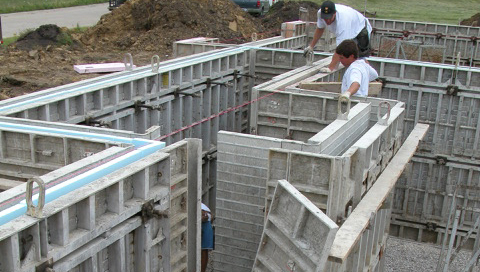
CFA member from Iowa is looking to reduce form inventory by selling a set of vertex brick textured “big” aluminum panel forms. These forms are 9-ft tall and have an inventory including:
- 8 – 6 ft (w) x 9 ft (h) [72″ x 108″]
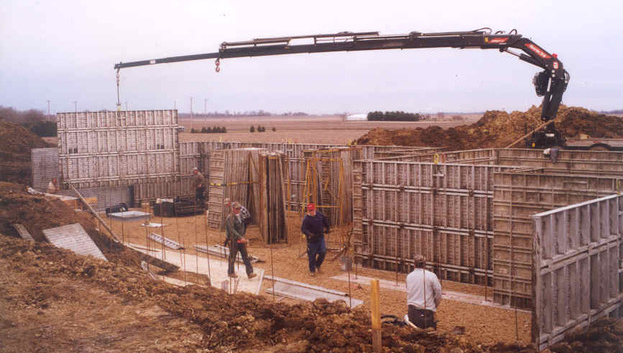
- 8 – 9 ft (w) x 9 ft (h) [108″ x 108″]
- 8 – 12 ft (w) x 9 ft (h) [144″ x 108″]
- 8 – 15 ft (w) x 9 ft (h) [180″ x 108″]
- 6 – 18 ft (w) x 9 ft (h) [216″ x 108″]
- 4 – 21 ft (w) x 9 ft (h) [252″ x 108″]
- 8 – 18 ft (w) x 4 ft (h) [216″ x 108″]
- 8 – 6×6 inside corners
For more information regarding these forms and any transaction interest, contact David Martinson, Ph. 319.232.4000.
Custom Concrete Expands Regionally with New Addition
The Central Indiana-based company has acquired Triple Q Foundations out of the Greater Cincinnati area
WESTFIELD, Ind. (Oct. 23, 2018) — Custom Concrete, central Indiana’s quality concrete contractor, today announced it has acquired Triple Q Foundations, based in Lebanon, Ohio. The acquisition was finalized on Oct. 1, 2018.
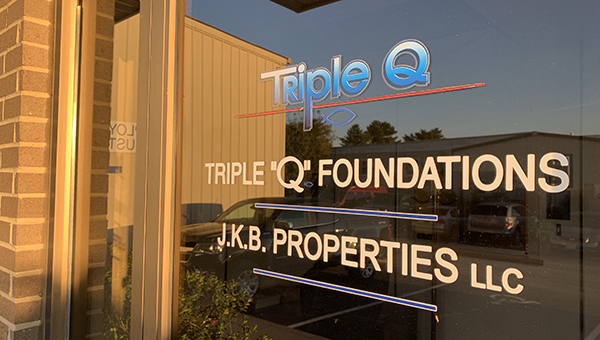
The addition of Triple Q Foundations expands Custom Concrete’s footprint beyond central Indiana to the tri-state region of southeastern Indiana, southwestern Ohio and northern Kentucky.
Triple Q owners John and Tim Ball announced their intention to sell the company on Sept. 24, 2018.
“Triple Q Foundations shares Custom Concrete’s desire and ability to be innovative, especially when it comes to taking care of its customers and employees,” said Triple Q co-founder John Ball. “We are confident this is a good match.”
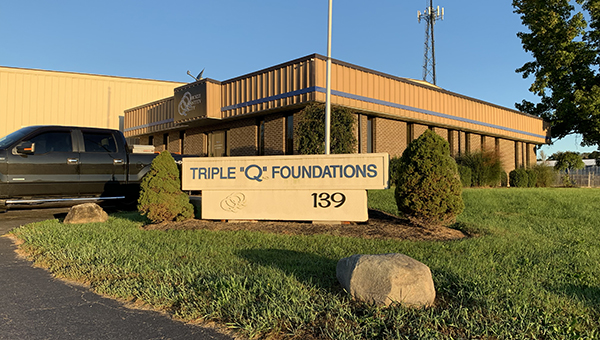
Darren Poore has been named president of Triple Q effective immediately. Poore was previously with Baker Concrete Construction for 13 years, managing numerous commercial and industrial concrete construction projects throughout the Midwest, southern United States as well as Colorado. Prior to Baker Concrete, Poore worked as the operations manager for Ball Brothers/Ball Concrete Construction focused on residential projects.
“We are excited to have Triple Q join our family,” said Custom Concrete Owner and CEO Brad Schrock. “John and Tim have created a great company and we are committed to making sure this change in ownership goes as smoothly as possible.”
Custom Concrete has been constructing foundations for the finest homes, commercial buildings and industrial facilities throughout central Indiana since 1969.
To learn more about Custom Concrete, visit http://customconcrete.com/.
Stephens & Smith Construction Company Revives Student-Learner Program
FEATURE ARTICLE:
Stephens & Smith Construction Company Revives Student-Learner Program
By Jereme Montgomery, Business Development
Many of you reading this article will testify that the skill gap is real. There is a shortage of skilled craftsmen in the construction industry, and it has continued (and will continue) to effect quantity and quality of structures built in America. I’d like to take it one step further: More important than the skill gap, is a lack of awareness regarding construction careers available. It is time the construction industry, and specifically the individual trades within it, take action. Let’s stop blaming the education system for lack of emphasis on trades. Let’s stop blaming parents for “brain-washing” youth into believing that a four-year college is the only path to success. If we truly want to see change in career awareness for construction trades, we have to become advocates at a local level. That is precisely what we are determined to do here at Stephens & Smith.
In May of 2018, leaders in the construction industry around Lincoln, Nebraska took it upon themselves to coordinate a “hands-on” construction career day. The Home Builders Association of Lincoln, in conjunction with Build Our Nebraska, worked with public and private schools to create an event dedicated to creating construction career awareness. Over twenty local construction companies and equipment suppliers sponsored multiple exhibits where youth could experience many of the activities or “jobs” associated with working in construction. These were jobs like driving skid loaders, operating backhoes, using hand tools, finishing concrete, and many other hands-on activities. It was the first construction career day organized in Lincoln for over a decade. During the event, I had the pleasure of meeting a 17-year-old student who was cleaning up from stamping some concrete. As I began a conversation, he said, “I want to do that. I want to be a concrete finisher.” Without hesitating I replied: “Say no more.” One month later, our company hired its first 17-year-old employee since the 1980s, Mr. Diamond Potter.
The U.S. Department of Labor’s Employment Standards Administration defines seventeen hazardous occupations in non-agricultural settings. According to the Fair Labor Standards Act, or the Wage-Hour Law, the safety and well-being of a young person is to be protected by employers. They may not allow minors to perform work that has been determined by the secretary of labor to be hazardous. Hazardous Occupation Orders generally prohibit youth under the age of 18 to engage in occupations and activities such as:
- Manufacturing and storing explosives
- Motor-vehicle driving and being an outside helper
- Coal mining
- Logging and saw milling
- Using power-driven woodworking machines (including saws)
- Being exposed to radioactive substances
- Operating power-driven hosting devices, including forklifts, cranes, and non-automatic elevators
- Using power-drive metal forming, punching, and shearing machines
- Mining other than coal mining
- Slaughtering or meat packing, processing or rendering, including the use of power-driven meat slicers*
- Operating power-driven bakery machines
- Using power-driven paper product machines, including paper balers*
- Manufacturing brick, tile, and similar products
- Using circular saws, band saws, and guillotine shears*
- Wreaking, demolition and ship-breaking
- Roofing operations*
- Excavating, including work in a trench as a plumber*
*Exemptions: Student-learners aged 16 or 17 enrolled in career education programs that meet the minimum requirements may be employed on a limited basis in the five hazardous occupations listed with an asterisk (*). Under these requirements, the agreement must provide that:
- The student-learner is enrolled in a course of study and training in a cooperative vocational training program.
- Student-learners employed under a written agreement must provide:
- That the work of the student-learner in the occupations declared particularly hazardous shall be incidental to his/her training;
- That such work shall be intermittent and for short periods of time, and under the direct and close supervision of a qualified and experienced person;
- That safety instructions shall be given by the school and correlated by the employer with on-the-job training; and
- That a schedule of organized and progressive work processes to be performed on the job shall have been prepared.
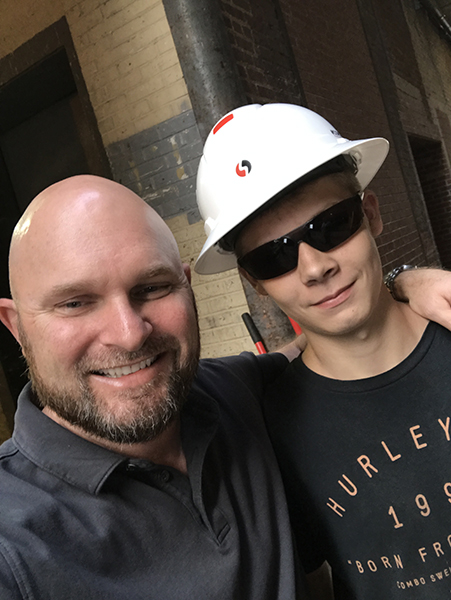 Sounds like a lot, and it should. Our industry can be dangerous without proper instruction or guidance. The safety of these student-learners is priority number one. Prior to the hiring of our student learner, Stephens & Smith Construction Company worked closely with the Nebraska Department of Education and the Nebraska Department of Labor to ensure we had all our “ducks in a row.” Since I volunteered to become Mr. Potter’s concrete mentor, I have had the pleasure of reviewing his first essay of the summer required for class. I quickly realized that this student-learner’s experience was not only about teaching career awareness, but was also about teaching life lessons. To prove this, his essay required him to answer three questions:
Sounds like a lot, and it should. Our industry can be dangerous without proper instruction or guidance. The safety of these student-learners is priority number one. Prior to the hiring of our student learner, Stephens & Smith Construction Company worked closely with the Nebraska Department of Education and the Nebraska Department of Labor to ensure we had all our “ducks in a row.” Since I volunteered to become Mr. Potter’s concrete mentor, I have had the pleasure of reviewing his first essay of the summer required for class. I quickly realized that this student-learner’s experience was not only about teaching career awareness, but was also about teaching life lessons. To prove this, his essay required him to answer three questions:
1. What can you learn from a job that you cannot learn in a traditional classroom?
Since my summer employment, I have learned many things about my job that I wouldn’t have learned in a traditional classroom. First, you can’t pour or finish concrete in a classroom. When you’re in a classroom you don’t get to interact with other concrete tradesman. Also, I have learned how equipment helps make our jobs easier. Most importantly I have learned by doing hands-on construction activities.
2. What do you like most about your job?
What I like most about my job is simply being outside. I enjoy NOT having to sit behind a desk and I enjoy the view when working outside. I also enjoy building things. It is nice to look back at what we built for the day and say, “I helped build that.” A couple other things I enjoy most about my job is the people [sic]. They are fun to work with, even when things get tough. Lastly, I definitely enjoy the money the most. This will help me fix my car and save up for an apartment when I graduate.
3. What do you like least about your job?
Early mornings are what I like the least. I have learned that in order to “beat the heat,” we have to start before the sun comes up. Then we have work in the hot sun for the rest of the day. It is hard work. I enjoy what I do and the people I work with. I’ve learned that you have to stay busy in order to earn respect from my co-workers. Earning respect is important with any job.
– Diamond Potter, June 29, 2018
This has been a true learning experience for us at Stephens & Smith. We realize that this opportunity is unique, and we hope other construction companies take advantage of this program next summer. Mr. Potter is the first student learner in Nebraska since the late 1980s who has taken the proper legal steps to work in Nebraska’s construction industry. This is great news for our industry and a great chance to show off our trades. It is high time more construction companies take advantage of student-learner programs. Local advocacy is, and will continue to be, the most effective recruitment tool we have in our toolbox. Don’t let it get rusty. Our path is not a difficult one to follow, and if your company is a CFA member, I would love to help you with a blueprint for understanding your state requirements and setting a path toward engaging student learners for your future operations.
Jereme Montgomery is the former Director of the Nebraska Concrete & Aggregates Association. He now serves as a business development member for CFA, Stephens & Smith Construction Company Inc. is located in Omaha and Lincoln, Neb. | @NEconcrete | www.stephensandsmith.com | JMontgomery@stephensandsmith.com
Resources:
- USDOL page with useful information: https://www.dol.gov/general/topic/youthlabor/hazardousjobs.
- Regulations (Subpart E for hazardous occupations): https://www.ecfr.gov/cgi-bin/text-idx?c=ecfr&sid=48d6ee3b99d3b3a97b1bf189e1757786&rgn=div5&view=text&node=29:3.1.1.1.31&idno=29#sp29.3.570.e.
- Safety resource for Young Worker Safety and Health: https://www.cdc.gov/niosh/topics/youth/.
- USDOL website designed for youth https://www.youthrules.gov/.
Get More Workers: How to Use an Employee Referral Program to Bring in More People
By Doug Herbert
How much does it cost a contractor to hire one employee? According to my concrete contractor buddies, Sean Smith from Cleveland, Ohio and Jason Ells from Indianapolis, Indiana, the amount is at least $1,000 per new employee. Based on my experience and calculations, that number is spot on.
Here are just some of the areas where we spend time and expenses when hiring an employee:
- Writing and placing the “Help Wanted” ad
- Reviewing the applications
- Interviewing the applicants
- Having the new hire fill out the new employee paperwork
- Sending the new hire down for a drug test (if your company requires that)
- Having the new hire go through company orientation
- And, finally, training – whether formal training, or just having them pick it up from the men on the job sites
Additionally, if you do any of these tasks yourself, you have to factor in the opportunity cost: If you were not spending your time doing this, you would likely be spending your time doing something more profitable. Examples of more profitable activities include getting a new customer, implementing a new system, or getting a better price on materials. The opportunity costs really make hiring an employee an expensive proposition.
When you add in the costs of people you hire who do not contribute on the job site and only last a few days or a few weeks, the costliness of the undertaking can become downright frightening.

Reduce Hiring Costs with Employee Referrals
One of the best ways to reduce these costs is to set up an employee referral program that encourages your employees to refer their friends and peers to join your company.
Referred employees are more likely to be better employees because birds of a feather flock together. Your good employees likely know other good workers. The people that they refer are usually better workers than a random person answering your “Help Wanted” ad.
Also, the referred person will feel more obligated to come to work every day because their friend will know if they call in sick or miss a day. Or, as we have seen happen, the new employee is more likely to get to work each day due to ride sharing with the one who referred them.
How to Set Up the Program
Set up an employee referral plan at your company for your current employees. When they refer someone to your company that you hire, they get a referral bonus if that new hire stays with you for a certain period of time.
I recommend that the new employee has to be there for 90 days before the referral bonus is paid out. On their 90th day, the employee that referred them gets the referral bonus.
What will motivate your employees to refer others to join your company? The answer is, simply, money. Sure, some people are motivated by other things like time off, prizes or perks. Money, however, is the universal motivator. Everyone has a use for it. Offer a monetary bonus between $150 and $400 as your referral reward. Consult with your attorney and accountant for the best way to do this.
Concrete contractors will often balk at that dollar amount. They think it is too high, but I believe it is very inexpensive compared to hiring the wrong person. The caliber of men you will get from employee referrals will almost always be better than guys just walking in off the street, applying for a job.
You want more people like your current employees. Your current employees know what the work is like, they know what is required of them, and what the hours are like. The people that they refer are going to be similar to them.
I love this concept because there really is not much risk for the contractor. If the new employee is not a good worker, then either they will quit or you will get rid of them before 90 days.
If they are a good worker and they have been there for 90 days, then they will probably stay for a while, which is what we want. Besides, you have made more on their labor up to this point than whatever the referral bonus is.
Five Common Mistakes
There are five common mistakes I often see contractors making when they implement an employee referral strategy.
 The first mistake is making the referral bonus too small. The bonus has to be big enough so your employees persuade others to work at your company. You want your employee to think about what they would do with all of that money. Fifty bucks is not going to motivate someone. It has to be a bigger reward than that.
The first mistake is making the referral bonus too small. The bonus has to be big enough so your employees persuade others to work at your company. You want your employee to think about what they would do with all of that money. Fifty bucks is not going to motivate someone. It has to be a bigger reward than that.
 The second mistake is not creating a good place to work. Employees will not refer their friends if they themselves do not enjoy working there. Be sure you provide a safe, reliable place to work, where your employees feel like they are a valuable part of a team and are appreciated.
The second mistake is not creating a good place to work. Employees will not refer their friends if they themselves do not enjoy working there. Be sure you provide a safe, reliable place to work, where your employees feel like they are a valuable part of a team and are appreciated.
 The third mistake contractors make with referral bonuses is that they pay some or all of the money when the referred person begins working at the company. For one thing, this is expensive. For another, we are trying to find people who will stay with the company, and will work hard enough not to get fired.
The third mistake contractors make with referral bonuses is that they pay some or all of the money when the referred person begins working at the company. For one thing, this is expensive. For another, we are trying to find people who will stay with the company, and will work hard enough not to get fired.
You do not want one of your employees sending you crappy people who do not last more than a week just so he or she can get the bonus. We must always reward the behavior we want repeated. So, pay the bonus to every person who refers someone who lasts more than 90 days.
 The fourth mistake I see is that contractors make the referral bonus program too complicated. They set it up so the referrer gets 50 bucks when the person starts, then both people will get 100 bucks after 60 days, then the referrer gets another 50 bucks if the person makes it 120 days. On top of all that, they will make all of those payments dependent on the guy coming in on a Tuesday at 9:00 AM to fill out the job application.
The fourth mistake I see is that contractors make the referral bonus program too complicated. They set it up so the referrer gets 50 bucks when the person starts, then both people will get 100 bucks after 60 days, then the referrer gets another 50 bucks if the person makes it 120 days. On top of all that, they will make all of those payments dependent on the guy coming in on a Tuesday at 9:00 AM to fill out the job application.
See, that is not going to work. Make your program so simple that everyone understands it. In fact, if you have a young child at home, explain your program to them over dinner and see if they understand it. I explained our program to my nine-year-old son. He instantly understood it and started thinking about who he could refer. If it is too complicated, then people will not do it.
 The fifth mistake is not making sure the employees know about the program, or not reminding them about it. You may know about the program, but do your employees remember it? You have to constantly remind them so when one of their buddies is looking for a new job, they can convince them to come to your company.
The fifth mistake is not making sure the employees know about the program, or not reminding them about it. You may know about the program, but do your employees remember it? You have to constantly remind them so when one of their buddies is looking for a new job, they can convince them to come to your company.
We remind our employees about the program during our weekly safety meetings. We also have a paper advertising the program right next to where their time cards are kept. They see that paper every morning.
Kirby Justesen of Salt Lake City, Utah reminds his employees of his referral program by posting it on the two doors leading into his shop and office. His laborers use both of those doors every day, so they are constantly reminded of the program.
If you currently have a referral bonus program and it is not working for you, or you tried it in the past and did not have success with it, then it is probably because of one of these five reasons.
The most likely reason is the amount is too low. To see if that is the problem, double or triple the bonus amount. Get it up to $300 or $500. Do not be cheap about this! Think about how much money you will make by completing more jobs with more people.
There is one other thing to consider – and this is a big one. Studies show that when employees say they are happy at work, it is mainly because of the friendships they have at their work. This reason is often cited for why they stay at a company. If your employees have friendships at work, then this will help brace your company for the turnover tidal wave as more and more millennials jump from one company to another after very short stints at any one place. This referral program will help reduce your turnover.
So, let this be the year you finally create an employee referral program at your company. Offer a big referral bonus, and continually tell people how they can make money by referring others to your company. You will be very happy with the results.

